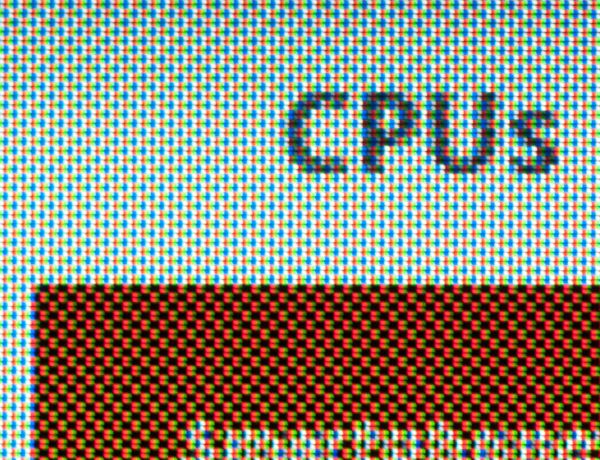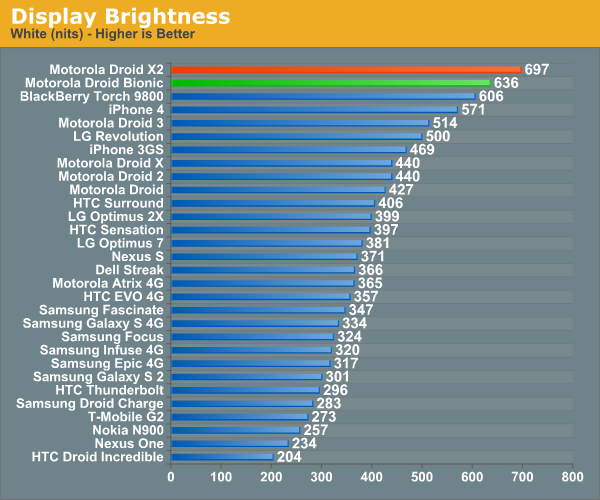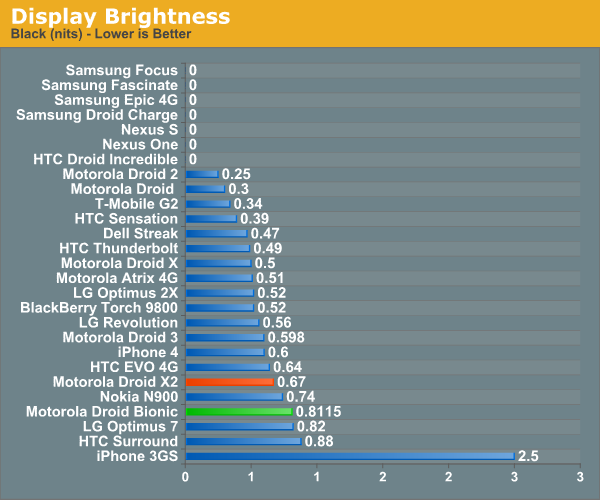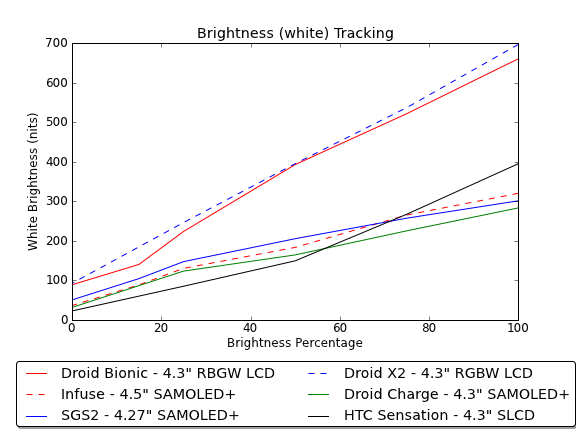Motorola Droid Bionic Review - Dual Core with 4G LTE
by Brian Klug on October 11, 2011 1:55 AM EST- Posted in
- Smartphones
- LTE
- Motorola
- OMAP 4
- Mobile
- motorola droid bionic
Display - qHD 4.3"
I went over this in our preview piece, but the Bionic literally uses the same display as the Droid X2. It’s a 4.3" qHD (960 x 540) panel with an RGBW PenTile subpixel matrix. The goal of PenTile in RGBW is to affect more light throughput at a given backlight brightness than a traditional RGB stripe. It seems simple enough in theory - R, G, and B filters in an LCD all incur losses, and having a white subpixel is an easy way to increase total throughput with a lower backlight level. Luminance gets mapped to the white subpixel, chrominance gets mapped to RGB, and in theory you get the same image with fewer incurred losses, and can drive the panel with less backlight power.

RGBW PenTile on the Motorola Droid Bionic
The side effect is that, like RGBG PenTile which we saw in Samsung’s AMOLED and SAMOLED, the grid is offset and thus renders vertical elements in a unique fuzzy manner. From far away enough, those offset elements look relatively homogenous or straight, but up close is where you can notice things aren’t a nice, straight grid. In other terms, instead of 3 subpixels per pixel in a normal RGB stripe, RBGW PenTile uses 2 subpixels per pixel. Nouvoyance also explains all of this on their own RGBW page.
I have to admit that I found RGBG PenTile distracting, but RGBW PenTile not nearly as much on these newer devices. Maybe I’ve just gotten used to it from seeing it crop up so many times now. It’s more noticeable on the Droid X2 and Bionic purely because the logical pixels are larger - same resolution, larger display (4.3“ as opposed to 4.0”), however.
Motorola earned something of a reputation for including good IPS displays in the original Droid all the way through the Droid 2. PenTile or not, the display does post good brightness and contrast numbers in our measurements with an i1D2 as always.



I also measured display brightness and white point as a function of brightness selected from the settings menu. This is something we’ve been doing for a while now, and it’s actually pretty cool to see the Bionic’s lines pretty much lie right atop the X2’s - for once, everything does make sense. Viewing angles and outdoor viewing quality is basically identical to what I saw on the X2, which is to say pretty darn good.


I like the Bionic’s display if nothing else because it’s qHD, even if this display is effective qHD resolution through RGBW PenTile rather than an RGB stripe. Higher dot pitch through any means necessary is something I’m ok with, and there are just so many places that qHD gives more breathing room than WVGA in Android.
















64 Comments
View All Comments
steven75 - Tuesday, October 11, 2011 - link
Except for the waiting for your battery to charge, as proven in the tests above.Omega215D - Tuesday, October 11, 2011 - link
Not all of us have that issue with LTE. Granted the battery life isn't something worth writing home about but it's sufficient, especially after receiving Gingerbread on my Thunderbolt. On my original Droid and my brother's iPhone 4 there were times when the system would be pegging the EVDO constantly when loading some web pages thus putting more strain on the battery.kepler - Tuesday, October 11, 2011 - link
I would be interesting to see how much data is consumed during the tests. If the LTE phone is consuming 4x the data, but lasting half the time, that is arguably 2x increase in possible productivity.Aikouka - Tuesday, October 11, 2011 - link
I'm assuming that there isn't much difference between the data. LTE modems simply seem to be power hungry, so running a constant stream of data will show pretty high battery use.This knowledge is good for some users, because for people that like to stream things like Pandora, they may consider turning off LTE (LTE isn't really required for streaming music). But what came to my mind while reading the article is that **constant data use tests** don't necessarily mimic the actions that all users take.
It'd be interesting if we could see power characteristics related to a single action. For example, how many YouTube videos could I load throughout a single charge of the battery? If the LTE-equipped phones can load 200 vs. 50 on EVDO (completely made-up numbers) simply because LTE provides significantly faster speeds, then that shows a rather large multimedia advantage.
Even without such a test, I think it's pretty easy to see that while LTE is pretty amazing to see in a phone... there's a lot of micro-managing that you may have to consider doing to see the sort of battery life that we've come to expect out of a phone.
secretmanofagent - Tuesday, October 11, 2011 - link
One thing that I would like to point out (and I think it's specific to Blur and worth mentioning) is the ability to dismiss individual notifications instead of having to open each individual notification or clearing all of them. I love that feature on the Bionic.I have seen some data connectivity issues with it where I will randomly lose all data and be unable to recover it until I reboot the phone (airplane mode doesn't fix it). This can happen at any point in the day or night, and I'm having my phone exchanged.
anandtech pirate - Tuesday, October 11, 2011 - link
nah, that's okay. we don't wanna see your face.... :-palmost all phone reviews only show the phone which is what people are watching to see.
LordConrad - Tuesday, October 11, 2011 - link
My Thunderbolt is rooted and running Andriod 2.3.4, courtesy of Das BAMF 3.0 RC4.9 rom.I've overclocked it from 1.0GHz to 1.2GHz
A few benchmark results:
Sunspider = 3092ms
GUImark 2 (fullscreen) = 48.32
LinPack (single-thread) = 44.831
GLbench 2.1 Egypt = 18.2
I'll stay with this until Qualcomm Krait gets here. Besides, I would much rather have a TFT screen at WVGA than a Pentile screen at qHD.
Omega215D - Tuesday, October 11, 2011 - link
Let's see what the Samsung Prime and the HTC Vigor have in store for us now that they are using HD screens.I have the OTA Gingerbread on my Thunderbolt. I get similar results without rooting or overclock. Battery life is longer as well. I just have to avoid downloading useless apps from the market though (thanks to a certain APK).
LordConrad - Tuesday, October 11, 2011 - link
I'm looking forward to the HTC Vigor also. I don't care for Samsung devices, the screens are nice but they feel cheap and are not as easy to root as newer HTC phones. The Thunderbolt was annoying to root and I'm not doing that again.I forgot to mention that I got the 3200mah extended battery from Seidio Online shortly after buying the phone. Also, the main purpose of rooting was to enable programs such as WiFi Tether. I refuse to pay an extra $30 for tethering since I never exceed my phone's 2GB data plan (tethering is only occasional).
jeepdinger - Tuesday, October 11, 2011 - link
I would be curious to see the number of times each page loads when the battery test is run. It was stated that several pages load continuously during the test. The new LTE speeds versus the slower 3G speeds should manage the same or more page loads for the same or less battery life. If this were true then there is a definite advantage to the LTE speeds even though the battery life seems less when the pages are continuously loaded. Is this something that could be added to the graphic, maybe as 2 bars per phone listed. Thanks.